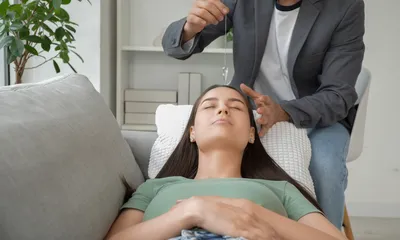Can Eye Problems Cause Neck Pain

Neck and vision-related issues are on the rise globally. The figures for neck pain have nearly doubled from 1990 to 2017, while the proportion of people with visual impairments and blindness is projected to double by 2050. These startling facts are often linked to extended periods of sitting, staring at laptops, TVs, and phone screens, as well as an overall sedentary lifestyle. While neck pain and eye issues are becoming increasingly common, you might wonder whether they are connected and if eye problems can cause neck pain or vice versa. Continue reading this article to learn about ways to prevent and treat these issues.
Can Eye Problems Cause Neck Pain?
At first glance, eye problems and neck pain might seem unrelated. Although eye issues aren’t a direct cause of neck pain, some factors associated with vision problems can negatively affect your neck. For example, this often occurs due to muscle tension and poor posture in the neck and shoulders, which is frequently caused by trouble seeing, digital eye strain, and blurry vision. In these cases, many people tend to squint or lean forward, holding their head in an unnatural position to see better, and clenching their jaw or tensing their facial muscles. Over time, this can lead to significant stress on your neck muscles and discomfort.
Can Neck Problems Cause Eye Problems?
Similarly, neck problems don’t directly impact your eye health. However, poor posture and chronic neck strain, which often accompany neck issues, can cause temporary eye pain that mimics real eye problems, such as tension headaches or pressure around and behind the eyes. Your eyes or forehead may also experience pressure, heaviness, and fatigue. Facial and eye pain are often linked to issues with the cervical spine, like a pinched nerve or inflammation. Some individuals also report blurry vision or light sensitivity.
How to Prevent and Relieve Neck and Eye Issues?
While problems with your neck and eyes aren’t dangerous, they can be very uncomfortable, making it difficult to stay productive at work and enjoy daily life. Fortunately, small changes in your routine can have a significant impact, such as keeping your vision prescription up to date, taking regular breaks from screens, and maintaining good posture through stretching and proper ergonomics.
Other helpful tips include setting your screen to eye level, using a chair with back support, and keeping your feet flat on the floor. Following the 20-20-20 rule, which involves taking a break every 20 minutes to look at something 20 feet away for 20 seconds, using proper lighting and blue light filters, and reducing screen time before bed, can also be highly effective. If symptoms persist despite these measures or you experience acute symptoms, consider taking over-the-counter pain relief such as Ibuprofen or Naprosyn for your neck. You may also use artificial tears or lubricating eye gels for your eyes.
If you continue to experience issues with your neck and eye strain, it’s recommended that you consult a doctor or physiotherapist. They can prescribe effective medications, such as Flexeril or Prednisolone eye drops, to relax your neck muscles or reduce inflammation in your eyes. A doctor may also assess the steps you take in your daily routine to help alleviate your pain. Finally, they can adjust and monitor your treatment plan, thereby enhancing your overall quality of life free from pain.


